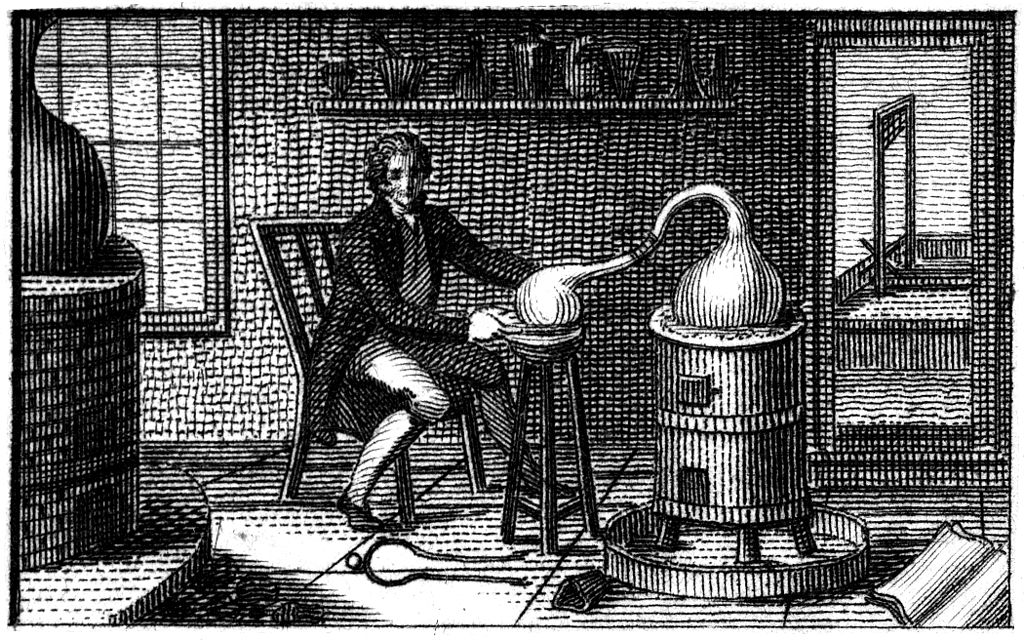What is lethal, invisible, and surrounds you all the time? Give up? Well, don’t be disheartened. The answer to this riddle eluded scientists for over 2,000 years before Antoine-Laurent de Lavoisier came onto the scene! Outside of Lavoisier’s unpopular political alignment at the time, and his unfortunate assassination during the French Revolution, Lavoisier contributed more to our modern understanding of science than many might know, and helped discover that lethal, invisible gas known as oxygen. So, how did Lavoisier accomplish such a feat?
In the late 1700s, the prevailing view among scientists was that air, and anything else that was combustible, had inside it a substance they called “phlogiston”, which was released upon burning. This was scientists’ premiere explanation for fire and combustion. Moreover, scientists were also entrenched in the belief that water was an element; a pure and uniform substance that cannot be broken down into smaller parts. Today, we know that water is made of one oxygen molecule and two hydrogen atoms (H2O).
In 1772, Lavoisier focused his attention on the process of combustion. While Lavoisier was hard at work researching the combustible properties of the two pure elements phosphorus and sulfur, as well as compounds similar to rust, he came across the work of Joseph Black. Black had recently published a study of the properties of a product he called “fixed air” that was released from compounds containing metals such as sodium and calcium and other lighter metals. Lavoisier reasoned that this “fixed air” must be the same air that was being produced during his combustion experiments.
Then, in 1774, Lavoisier was visited by English and cutting-edge combustion scientist Joseph Priestly who shared with Lavoisier an experiment that involved the burning of a mercury compound called “red calcx” and its results. Priestley had discovered that the gas released from this experiment was more flammable and easier to breath than common air. Lavoisier continued to study this phenomenon and concluded that the released gas was a unique element with distinct chemical properties. Moreover, Lavoisier correctly assumed that it was the pure air that was reacting with metals as well as non-metals during combustion. He astutely observed that no matter the material that was burned, the product always ended up more acidic than its reactant, and thus named the chemical in the pure air “oxygen,” from the Greek words meaning “acid former”. However, Priestley was a supporter of the phlogiston hypothesis and claimed that Lavoisier had created or isolated dephlogisticated air, a gas which had been deprived of its phlogiston, and was thus more flammable and purer than “common air”, and so the scientific community split.
After consulting with Priestley, Lavoisier decided that the secret behind convincing others of the existence of oxygen might be hidden within a common by-product of the combustion process; water. Thus, he turned his attention to studying the properties and composition of water, which many thought was an element at the time.
Meanwhile, back in England, another scientist Henry Cavendish recently published his findings on what he called inflammable air (later to be called hydrogen). Here’s where things get dramatic: Lavoisier was informed of Cavendish’s experiment and it’s result by resident bad-boy scientist Charles Blagden a full year before the study was published. This allowed Lavoisier to get a jump on the rest of the chemists at the time. In modern day science, this is called “scooping,” and is frowned upon as being unethical.
Lavoisier came to a sudden conclusion that water was not an element after all, but the combination of this “inflammable gas” with Priestley’s “pure common air”. After teaming up with some famous 18th century scientists such as Pierre Simon de Laplace and Jean-Baptiste Meusnier, Lavoisier worked to synthesize water from hydrogen and oxygen, though they were not yet called hydrogen and oxygen.
In one of his experiments, Lavoisier filled a glass dome called a bell jar with oxygen and introduced hydrogen and a spark simultaneously. This formed water droplets on the inside of the bell jar. He was even able to reasonably predict the amount of water that would be produced from the reaction. However, scientists continued to doubt Lavoisier’s conclusions that the elements were combining to create water, and instead said that water was part of the phlogiston combustion process that was occurring when the air ignited. In order to further prove his point, Lavoisier decided to separate water without combustion or fire. By flowing water through an iron tube that was red hot, the oxygen in the water combined with the iron to make iron oxide, and hydrogen gas was produced and escaped out the other end of the tube. Now he had proof that water could be broken down into more components. Although many still doubted his results, he began to invite chemists, scientists, and opponents alike into his lab to conduct the experiments for them, consistently breaking down and synthesizing water as the final product in two separate, unrelated reactions.
Soon after his invention, he published the book Elements of Chemistry: what many scientists claim as the first and most foundational chemistry textbook. Elements of Chemistry laid out cutting-edge and incredibly important principles of chemistry, such as the principle of the conservation of mass, a new, universal chemical naming system that we still use today, and a clear definition for an element. Sadly, due to Antoine Lavoisier’s economic beliefs, wealth, and prominent position within the French regime, he was erroneously beheaded during the French Revolution. Nevertheless, his work lives on as one of the foundations of our modern understanding of chemistry.
Additional References
- https://www.acs.org/content/acs/en/education/whatischemistry/landmarks/lavoisier.html
- https://archive.org/details/edgeofobjectivit00char/page/228
- https://books.google.com/books?id=N9ifbmgWLAIC&pg=PA115#v=onepage&q&f=false
- https://library.si.edu/digital-library/book/traiteyeyleyment1lavo
- https://www.beautifulchemistry.net/lavoisier


